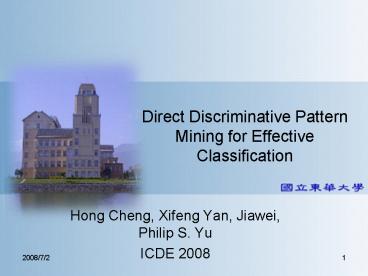Direct Discriminative Pattern Mining for Effective Classification - PowerPoint PPT Presentation
1 / 19
Title:
Direct Discriminative Pattern Mining for Effective Classification
Description:
Direct Discriminative Pattern Mining for Effective Classification ... Using information gain indicate an upper bound of discriminative measures ... – PowerPoint PPT presentation
Number of Views:105
Avg rating:3.0/5.0
Title: Direct Discriminative Pattern Mining for Effective Classification
1
Direct Discriminative Pattern Mining for
Effective Classification
- Hong Cheng, Xifeng Yan, Jiawei, Philip S. Yu
- ICDE 2008
2
Outline
- Introduction
- DDPMine approach
- Experimental results
- Conclusion
3
Introduction
- Frequent Pattern-Based Classification
- Frequent itemset mining
- Feature selection
- Model learning
- The cost is too expensive
- Generating the complete set of frequent patterns
- Feature selection is in post-processing
4
(Cont.)
- To avoid generating the complete set of frequent
patterns - To directly mine highly discriminative patterns
for classification
5
DDPMine
- For efficiency concerns
- To directly mine a set of highly discriminative
patterns - Branch-and-bound search
- For accuracy consideration
- To impose a feature coverage constraint
- An instance elimination process
6
Branch-and-Bound Search
- Using information gain indicate an upper bound of
discriminative measures - To adopt FP-growth and IG to facilitate a
branch-and-bound
7
(cont.)
- Example
- IG(d)0.016 ? maxIG0.016
- IGub(3)0.467gt maxIG ? cannot prune the
conditional FP-tree - recursive mining on conditional FP-tree and
get ad,bd,cd,abd - IG(ad)0.123,IG(bd)0.123,IG(cd)0.074,IG(abd
)0.123
8
(cont.)
- IG(a)0.811 ?maxIG
- IGub(6)0.811maxIG ?the conditional FP-tree can
be pruned without any mining
9
(cont.)
- Information gain upper bound
10
Training instance Elimination
- Goal To ensure every training instance is
covered by one or multiple features - Transaction-centered
- feature-centered
- Transaction-centered To mine a set of
discriminative features to satisfy the feature
coverage constraint for each training instance - Cost Tmining m.Tcheck_db
The number of frequent itemsets generated
11
(Cont.)
- Feature-Centered Approach
- Goal it want to directly mine discriminative
features while reducing the number of check_db
operations
12
Example
c7
b1
0
2
d1
b6
a1
0
1
500
600
d1
a5
0
0
100,300,700,800
400
d1
0
200
13
Feature coverage
- For accuracy consideration, it generate multiple
features to represent a transaction. - d a transaction is eliminated from further
consideration when it is covered by at least d
features - Keep a counter for each transaction when a
counter reach d, the corresponding transaction is
removed from the tree - Ctable the counters are stored in an array of
integers - Htable keep track of the features that are
already discovered
14
(Cont.)
- DDPMine works in an iterative way and terminates
when the training DB becomes empty.
15
Experimental Results
- Two other methods
- HARMONY
- instance-centric rule-based classifier.
- Pruning methods
- PatClass
- Frequent pattern-based classifier
- Two-step procedure
16
(Cont.)
- Efficiency Comparison
17
(Cont.)
- Accuracy Comparison
18
(Cont.)
- Problem Size Reduction
19
Conclusion
- Effective for classify categorical or high
dimensional spare datasets - Reduce the search space without downgrade the
accuracy and efficiency

